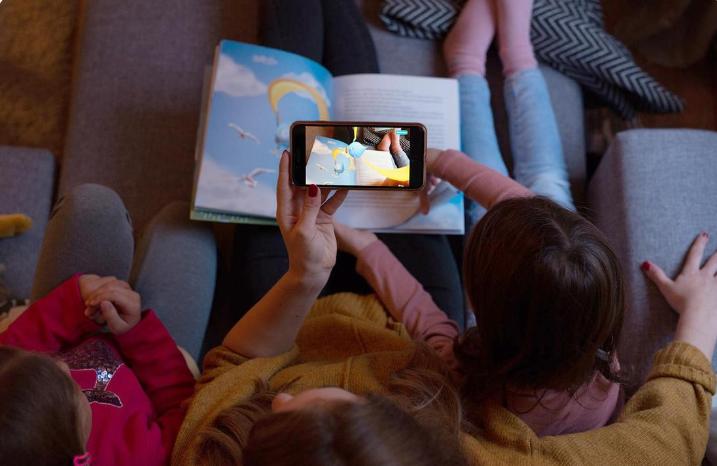What are Augmented Reality Books?
Augmented reality books are an innovative and interacting way of reading. They integrate and combine conventional book contents with digital features. For this purpose, they use digital apps or devices to superimpose digital features over conventional content. This provides the users with more information and interactive elements like animations. In this way, the reading content becomes more engaging, interactive and fun.
How AR Books Work?
Understanding the technical aspects of an AR book will give a better view of its working. This involves two types of AR book displays: head mounted displays (HMDs) and non-head mounted displays, (Non HMDs). These displays work to overlay digital features over physical contents using marker-based and non-marker-based tracking.
Marker-based tracking is more common than the other. AR devices can read the markers on the books to integrate interactive features. AR books have a graphical user interface (GUI) which uses a mouse, keyboard and screen. There is also a tangible user interface (TUI) which uses markers, paddles and real-life objects.
Components of AR Books
Visual Elements
AR books enhance the user’s reading experience by making it more immersive and realistic. It uses visual components like images, videos and animations to make it more engaging than traditional reading contents. The addition of these interactive elements helps the user understand the text better. This connects them with content and author’s imaginary world more deeply.

source: www.rooom.com
Interactive features
Addition of interactive elements is a necessary element of augmented reality books. These elements allow the user to adapt, explore and interact with the contents of book more effectively. Users can use many features like rotating 3D objects, solving riddles and discovering hidden secret contents. These interactive features give users a more engaging and personalized experience of AR books.

source: vimeo, interactive magazine animation
Uses of AR in books
Children’s literature
Adding realistic and exciting features to reading materials allow the kids to engage with the content as they would in real life. Textbooks can use AR technology to convert simple images into 3D models. This can be easily accessed through smartphones and AR glasses.
You can take example of books like Ocean Monsters, Tide Pools, and Space Race. These interactive books teach the kids about space and ocean in very intriguing and engaging ways. Kids can also play and experiment with various 3D models and learn new things easily.

source: pinterest, learning material
Fiction
AR technology can make fictional worlds come to real life in literature, giving readers a more exciting reading experience. Augmented reality features can be added to pop-up books and illustrated novels to make the stories more alive and interactive.
Augmented reality in books lets readers dive into their favorite story worlds. This creates a connection between the reader and his imaginative world making the reading experience more interactive.

source: Pinterest, the little mermaid
Healthcare
Augmented reality books can be beneficial for students studying medicine and healthcare. It can give very clear depictions of body parts, their functions, and surgery methods when added to learning materials.
The integration of digital and physical materials allows for a more thorough and interesting presentation of information. This method improves medical training by boosting understanding and retention of information.

source: youtube, AR Books Library UK
Benefits of AR books
Interactive reading
AR technology gives readers a fully immersive reading experience. It can make educational material engaging by adding games or videos that users can interact with. This helps users to grasp complex concepts in a simple way. Moreover, augmented reality enhances printed materials with interactive experiences like 3D projections and virtual tours. This allows the users to connect with the content on a deeper level.

source: rawpixel.com, freepik.com
Better memorization
The primary benefit of augmented reality for studying is a better understanding and memorization of complex materials. Using augmented reality storybooks increases student engagement and interest. This can sharpen their focus, memory, creativity, and problem-solving abilities.
The use of AR books increases literacy acquisition rates even in young children. Using both printed and digital material together helps kids with disabilities understand and memorize things faster and better.

source: vimeo, aftonbladet Altas
Increased motivation
Students also agree that they perceive AR-enriched information more favorably and intend to use it more. AR books let readers enter a world that relates to their activities and is fun to explore. For example, kids can tap on certain parts of the book to activate animations. This will spark their interest and make them want to read more. This involvement enhances the reading experience and keeps the reader engaged.
How to create an augmented reality book
Decide the content
Which sections of your written or visual content should provide an augmented experience? Consider it beforehand to avoid compromising the integrity of the book. You can also experiment with what kinds of noises, effects, and 3D elements you want to use.
Paper or electronic version?
The AR features of a printed book and digital book will be different. The producers should think about what kinds of markers they need to put in the printed version, or what kinds of links and other interactive parts they need to add to e-books and the AR apps that go with them.
Pick your AR tools
You can use off-the-shelf SDKs (software development kits), editors, and 3D catalogues for your AR book. But it depends on the complexity and 3D elements of your book. You can also make your own AR app according to your specific requirements. Kivicube is a user-friendly AR platform for creating and managing AR experiences without having a lot of programming skills.
Conclusion
Augmented reality has the potential to turn books into interactive exploration hubs. Interactive augmented reality books will be a crucial part of the future book market. Technology has advanced to the point where any aspect of books can be converted into multimedia content without affecting the book’s aesthetic. It works even if the book is already printed. As AR technology evolves, the field of augmented reality books is sure to witness more advances in near future. You can try on various augmented reality book solutions on Kivisense.






